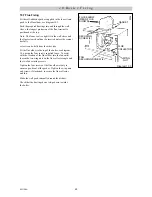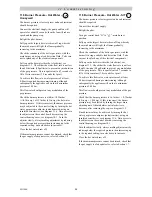
9
221129A
4 H e a t i n g S y s t e m
4.1 General Notes
The boiler is intended for use in a sealed system only.
4.2 Safety Valve
The safety valve is an integral part of the boiler.
It cannot be adjusted but has a manual test device.
4.3 Pressure Gauge
A pressure gauge is incorporated into the boiler to
indicate the system pressure.
The gauge has a cold fill set pointer.
4.4 Pump
The circulation pump is integral with the boiler.
The remaining circulating pressure head available from
the boiler is shown in diagram 4.1, Grundfos or diagram
4.1a, Glow-worm Wilo.
4.5 Expansion Vessel
The boiler has an integral expansion vessel with a
capacity of 8Litres, (1.76gall). If the system water
content exceeds the maximum quoted in Section 1, Data,
an additional vessel should be connected into the system
as close as possible to the central heating return
connection of the boiler, see diagram 4.2.
The pressure shall not be less that the static head at the
point of connection, that is, the height of the top point of
the system above the expansion vessel.
4.6 Flow Rate
A valve must be incorporated in the main flow or return
of the system, valve “A” shown in the flow diagram 4.2.
This valve must be lockable and positioned so that
inadvertent closure or unauthorised interference is not
possible. The design differential can be between 11
o
C
(20
o
F) and 17
o
C (30
o
F), dependent upon the system
resistance and the available pump head.
Grundfos Pump
The pump adjuster should normally be left at maximum
(3) but in some cases it is permissible to adjust the pump
to a lower setting (2), see diagram 4.1.
To use diagram 4.1 start with the required heating
system load.
In the example shown the maximum boiler output has
been chosen, 16.1kW (55,000Btu/h).
Draw a horizontal line from the required system
differential temperature axis to intersect the curve.
In the example 11
o
C (19.8
o
F) has been chosen,
shown - - - - -. At the point of intersection draw a
vertical line to cross the pump curve, from this point
draw a further horizontal line to determine the available
pump head. In the example 2.7m (9ft) is available. A
greater pump head can be achieved by choosing a higher
system differential temperature, up to a maximum of
4.6m (15ft) at a system differential of 17
o
C (30.6
o
F).
The system must be designed such that the available
pump head is not exceeded.
If the heating system load is less than 13.2kW
(45,000Btu/h) then it is permissible to adjust the pump
setting to (2), shown This results in an available
pump head of 2.1m (7ft). This is the maximum that can
be achieved with the pump at this setting.
Glow-worm Wilo Pump
The pump adjuster should normally be left at maximum
(2) but in some cases it is permissible to adjust to a lower
setting (1), see diagram 4.1a.
To use diagram 4.1a start with the required heating
system load.
In the example shown the maximum boiler output has
been chosen, 16.1kW (55,000Btu/h).
Draw a horizontal line from the required system
differential temperature axis to intersect the curve. In
the example 11
o
C (19.8
o
F) has been chosen,
shown . At the point of intersection draw a
vertical line to cross the pump curve. From this point
draw a further horizontal line to determine the available
pump head. In the example 2.7m (9ft) is available. A
greater pump head can be achieved by choosing a higher
system differential temperature, up to a maximum of
4.6m (15ft) at a system differential of 17
o
C (30.6
o
F).
The system must be designed such that the available
pump head is not exceeded.
If the heating system load is less than 13.2kW
(45,000Btu/h) then it is permissible to adjust the pump
setting to (1), shown This results in an available
pump head of 4.2m (13ft9in). This is the maximum than
can be achieved with the pump at this setting.










































